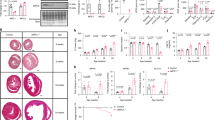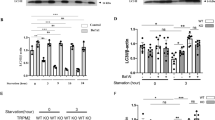Abstract
Lactate is formed and utilized continuously under fully aerobic conditions. Lactate is oxidized actively at all times, especially during exercise. Family of monocarboxylate transport proteins (MCTs) that are differentially expressed in cells and tissues accomplishes the facilitated transport of lactate across membranes. Previously we reported that there is MCT1 in blood circulation. We also reported the pressure stress stimulated cell proliferation in aortic smooth muscle cells (HASMC). In this experiment we attempted to prove the existence of MCT1 in HASMC and to clarify the effect of pressure stress on MCT1 localization in HASMC. We determined succinate dehydrogenase (SDH) activity as a marker of energy metabolism in cells. SDH activity was increased by pressure stress. Lactate enhanced the SDH activity under pressure stress (160 mmHg for 3 h) as dose dependent manner. On the other hand, lactate excretion was suppressed by the addition of lactate. We could detect MCT1 in the cytosolic and the membrane fractions of HASMC. The pressure stress increased MCT1 in the membrane fraction in the presence of extracellular lactate. In summary, we proved the existence of MCT1 in HASMC. Pressure stress changed the localization of MCT1. The increased membranous MCT1 may transport lactate for energy metabolism in cells.
Similar content being viewed by others
References
Gertz EW, Wisneski JA, Neese R, Bristow JD, Searle GL, Hanlon JT: Myocardial lactate metabolism: Evidence of lactate release during net chemical extraction in man. Circulation 63: 1273-1279, 1981
Gladden LB: Muscle as a consumer of lactate. Med Sci Sports Exerc 32: 764-771, 2000
Juel C: Lactate-proton cotransport in skeletal muscle. Physiol Rev 77: 321-358, 1997
Gertz EW, Wisneski JA, Stanley WC, Neese RA: Myocardial substrate utilization during exercise in humans; dual carbon-labeled carbohydrate isotope experiments. J Clin Invest 82: 2017-2025, 1988
Garcia CK, Goldstein JL, Pathak RK, Anderson RG, Brown MS: Molecular characterization of a membrane transporter for lactate, pyruvate, and other monocarboxylates: Implications for the Cori cycle. Cell 76: 865-873, 1994
Halestrap AP, Price NT: The proton-linked monocarboxylate transporter (MCT) family: Structure, function and regulation. Biochem J 343: 281-299, 1999
Fishbein WN: Lactate transporter defect: A new disease of muscle. Science 234: 1254-1256, 1986
Baker SK, Tarnopolsky MA, Bonen A: Expression of MCT1 and MCT4 in a patient with mitochondrial myopathy. Muscle Nerve 24: 394-398, 2001
Merezhinskaya N, Fishbein WN, Davis JI, Foellmer JW: Mutations in MCT1 cDNA in patients with symptomatic deficiency in lactate transport. Muscle Nerve 23: 90-97, 2000
Hatta H, Tonouchi M, Miskovic D, Wang Y, Heikkila JJ, Bonen A: Tissue-specific and isoform-specific changes in MCT1 and MCT4 in heart and soleus muscle during a 1-yr period. Am J Physiol Endocrinol Metab 281: E749-E756, 2001
Johannsson E, Lunde PK, Heddle C, Sjaastad I, Thomas MJ, Bergersen L, Halestrap AP, Blackstad TW, Ottersen OP, Sejersted OM: Upregulation of the cardiac monocarboxylate transporter MCT1 in a rat model of congestive heart failure. Circulation 104: 729-734, 2001
Bonen A: Lactate transporters (MCT proteins) in heart and skeletal muscles. Med Sci Sports Exerc 32: 778-789, 2000
Iizuka K, Morita N, Nagai T, Hanada A, Okita K, Yonezawa K, Murakami T, Kitabatake A, Hideaki Kawaguchi: A 44-kDa of protein identical to the N-terminal amino acid sequence of MCT1 in human circulation. Mol Cell Biochem (in press)
Weiser MC, Majack RA, Tucker A, Orton EC: Static tension is associated with increased smooth muscle cell DNA synthesis in rat pulmonary arteries. Am J Physiol 268: H1133-H1138, 1995
Setoguchi M, Ohya Y, Abe I, Fujishima M: Stretch activated wholecell currents in smooth muscle cells from mesenteric resistance artery of guinea pig. J Physiol 501: 343-353, 1997
Tsuda Y, Okazaki M, Uezono Y, Osajima A, Kato H, Okuda H, Oishi Y, Yashiro Y, Nakashima Y: Activation of extracellular signal-regulated kinases is essential for pressure-induced proliferation of vascular smooth muscle cells. Eur J Pharmacol 446: 15-24, 2002
Ozaki T, Iizuka K, Suzuki M, Murakami T, Kitabatake A, Kawaguchi H: Threshold-dependent DNA synthesis by pure pressure in human aortic smooth muscle cells: Gialpha-dependent and-independent pathways. Biochem Biophys Res Commun 256: 212-217, 1999
Kawaguchi H, Ozaki T, Murakami T, Iizuka K: Mechanical stress and human aortic smooth muscle cell proliferation. Exp Clin Cardiol 6: 24-28, 2001
Kawaguchi H, Sawa H, Yasuda H: Mechanism of increased angiotensin-converting enzyme activity stimulated by platelet-activating factor. Biochem Biophys Acta 1052: 503-508, 1990
Iizuka K, Murakami T, Kawaguchi H: Pure atmospheric pressure promotes an expression of osteopontin in human aortic smooth muscle cells. Biochem Biophys Res Commun 283: 493-498, 2001
Kawaguchi H, Sawa H, Yasuda H: Effect of atrial natriuretic factor on angiotensin converting enzyme. J Hypertens 8: 749-753, 1990
Kageyama K, Murakami K, Iizuka K, Sato K, Ichihara K, Tokumitsu Y, Kitabatake A, Kawaguchi H: Translocation of G protein β3 subunit from the cytosol pool to the membrane pool by β1-adrenergic receptor stimulation in perfused rat hearts. Biochem Pharmacol 58: 1497-1500, 1999
Watanabe M, Kawaguchi H, Onozuka H, Mikami T, Urasawa K, Okamoto H, Watanabe S, Abe K, Kitabatake A: The chronic effect of enalapril and amlodipine on cardiac remodeling in cardiomyopathic hamster hearts: Ca2+ antagonist and ACEI in cardiomyopathy. J Cardiovasc Pharmacol 32: 248-259, 1998
Urasawa K, Yoshida I, Takagi C, Onozuka H, Mikami T, Kawaguchi H, Kitabatake A: Enhanced expression of β-adrenergic receptor kinase 1 in the hearts of cardiomyopathic hamsters, BIO 53.58. Biochem Biophys Res Commun 219: 26-30, 1996
Pilegaard H, Domino K, Noland T, Juel C, Hellsten Y, Halestrap AP, Bangsbo J: Effect of high-intensity exercise training on lactate/H+ transport capacity in human skeletal muscle. Am J Physiol 276: E255-E261, 1999
Johnsen AR, Bendixen K, Karlson U: Detection of microbial growth on polycyclic aromatic hydrocarbons in microtiter plates by using the respiration indicator WST-1. Appl Environ Microbiol 68: 2683-2689, 2002
Brooks GA: Mammalian fuel utilization during sustained exercise. Comp Biochem Physiol Biochem Mol Biol 120: 89-107, 1998
Van Hall G: Lactate as a fuel for mitochondrial respiration. Acta Physiol Scand 168: 643-656, 2000
Garcia CK, Goldstein JL, Pathak RK, Anderson RG, Brown MS: Molecular characterization of a membrane transporter for lactate, pyruvate, and other monocarboxylates: Implications for the Cori cycle. Cell 76: 865-873, 1994
Bonen A: The expression of lactate transporters (MCT1 and MCT4) in heart and muscle. Eur J Apple Physiol 86: 6-11, 2001
Dubouchaud H, Butterfield GE, Wolfel EE, Bergman BC, Brooks GA: Endurance training, expression, and physiology of LDH, MCT1, and MCT4 in human skeletal muscle. Am J Physiol Endocrinol Metab 278: E571-E579, 2000
Poole RC, Halestrap AP: Identification and partial purification of the erythrocyte L-lactate transporter. Biochem J 283: 855-862, 1992
Shimozono M, Scofield MA, Wangemann P: Functional evidence for monocarboxylate transporter (MCT) in strial marginal cells and molecular evidence for MCT1 and MCT2 in stria vascularis. Heart Res 114: 213-222, 1997
Brooks GA, Dubouchaud H, Brown M, Sicrello JP, Buts CE: Role of mitochondria lactate dehydrogenase and lactate oxidation in the intracellular lactate shuttle. Proc Natl Acad Sci USA 96: 1129-1134, 1999
Author information
Authors and Affiliations
Rights and permissions
About this article
Cite this article
Oikawa, K., Iizuka, K., Murakami, T. et al. Pure pressure stress increased monocarboxylate transporter in human aortic smooth muscle cell membrane. Mol Cell Biochem 259, 151–156 (2004). https://doi.org/10.1023/B:MCBI.0000021366.62189.9d
Issue Date:
DOI: https://doi.org/10.1023/B:MCBI.0000021366.62189.9d




